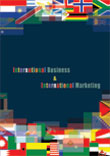International Business and International Marketing
 |
Details
Textbook:
Pages : 328;
Paperback;
210 X 275 mm approx.
Suggested Case Studies
Workbook:
Pages :
280; Paperback;
210 X 275 mm approx, Sample Applied Theory Questions
Sample Multiple Choice Questions (Online Quiz)
Pricing
Textbook Price: Rs. 750;
Workbook Price: Rs. 700;
Available only in INDIA
Buy Now
Please allow 5 to 10 days for delivery.
Detail Table of Contents
An Overview of the World Economy : Chapter 1
SUMMARY:
India has managed an average economic growth rate of 6% since the 1990s. In the period 2000-2003, it averaged 5.8%. In the 1990s, the major contributors to Indian GDP have been traditional farming, modern agriculture, handicrafts, a wide range of modern industries, and support services. India has a history of high inflation rates. However, in recent years it has been well under control. The RBI has been promoting liquidity in the economy since 1996. It took measures such as reducing the CRR, cutting short-term lending rates, and allowing banks to lend loans in foreign currency. The growing fiscal deficit is a macroeconomic problem the Indian economy faces. India’s trade has been booming in recent years with increasing IT exports. |
|
world.Brazil's economy is expected to recover in 2004 after going through a bad phase in 2003. Brazil experienced high inflation in 2002 and 2003.According to the central bank of Brazil, the fiscal deficit of the regional governments and state owned enterprises grew by 1.1 % of GDP during 2003. The currency of Brazil, the real has been stable in the second half of 2003. The government does not want the currency’s value to appreciate in the future as it fears that this might hurt its exports.
Economic growth in China in 2004 is expected to be around 7.7 %. Despite the high level of money circulating in the economy, the People’s Bank of China (PBOC), the Chinese central bank, does not favor an increase in interest rates. Government spending has been quite high in years 2002 and 2003. The current account surplus of China decreased from 2.9% of GDP in 2002 to 1.8% in the first half of 2003.
The US economy is the largest and most developed economy in the world. The economy grew at 3.3% in the second quarter of 2003. The economy posted strong growth of 8.2% in the third quarter. The inflation rate is expected to fall in 2004 due to lower food and energy prices. It is expected that the US Federal Bank will continue its low interest rate policy at least until the middle of 2004. The US fiscal deficit is mounting. The deficit as on March 2004 was US $ 129 billion. The dollar has lost its value by as much as 21% since early 2002 period. US exports are picking up. But trade is not a significant contributor to growth in the US economy at present.
Germany is the largest economy and the most populous country in Europe. The GDP of Germany grew by 0.4% in the first quarter of 2003. It fell by 0.7% in the second quarter. Inflation has been low in recent years. It was 2.0% in 2001, 1.4% in 2002 and 0.7% in May 2003. Germany had an unemployment rate of 10.7% in April 2003. This is a marginal increase over the last two years (10.1% in 2002 and 9.6% in 2001). Fiscal policy was restrictive in 2003. It aimed at reducing the budget deficit. This policy is expected to continue in the next few years as well. Germany had a trade surplus of 119.2 billion euro in 2003 compared to 124.4 billion in 2002.



